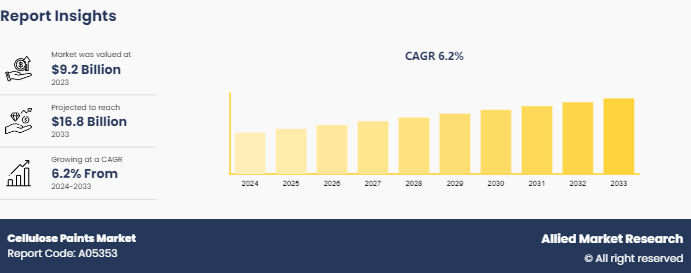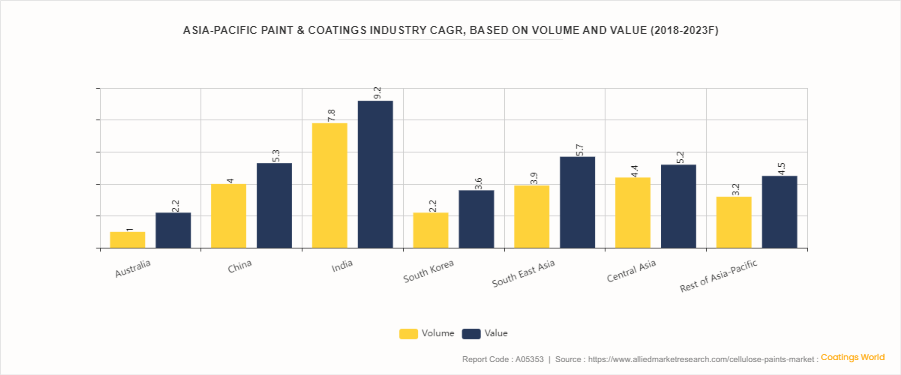Cellulose Paints Market Research, 2033
The global cellulose paints market size was valued at $9.2 billion in 2023, and is projected to reach $16.8 billion by 2033, growing at a CAGR of 6.2% from 2024 to 2033.

Market Introduction and Definition
Cellulose paints are plant-based coatings that are painted in a variety of layers when compared to conventional paints. These are a mixture of one or more pigments and are temporary in nature, so they can easily be removed at the time of another coating. These paints have lower hiding power and opacity properties. They contain non-ionic cellulose, which acts as thickeners, stabilizers, retaining agents for water-based paints for decorative applications. Manufacturer of cellulose paints treat all the paint grades with glyoxal to avoid the lump formation at the time of addition of water. It exhibits the capacity to scatter the pigments in the form of active agents with polymeric surface by improving the stream amid granulating in cellulose paints. Cellulose reacts with various substituents such as hydroxyethyl, methyl, and ethyl during cellulose paint production. The main advantages of cellulose paints over modern automotive paints are its ease of application and easy rectification of mistaken paintings. It contains pigment powder, talc, calcite, nitrocellulose solution, methyl ethyl ketone, acetone, toluene, cellulose thinner, bentonite, short oil alkyd resin, and wetting agent.
Key Findings
- Over 1,250 product literatures, industry releases, annual reports, and various documents from major cellulose paints market participants, along with credible industry journals, trade association releases, and government websites, have been reviewed to generate valuable industry insights.
- The cellulose paints market study covers 20 countries. The research includes a segment analysis of each country in terms of value for the projected period.
- The study integrated high-quality data, expert opinions and analysis, and crucial independent perspectives. This research approach aims to provide a balanced view of global markets and cellulose paints market overview, assisting stakeholders in making informed decisions to achieve their most ambitious growth objectives.
- Cellulose paints market news and key industry trends are also included in the report.
Market Dynamics?
The cellulose paints market has experienced robust growth due to increasing demand for eco-friendly and sustainable coatings, particularly within the automotive and furniture industries. Cellulose paints are highly valued for their quick drying times, excellent adhesion, and smooth finish, which make them suitable for a variety of applications. Their ability to deliver high-quality results efficiently has driven their popularity across multiple sectors. However, the market faces several challenges. One significant restraint is the high cost of raw materials, which impacts the overall affordability of cellulose paints. In addition, concerns over volatile organic compounds (VOCs) present in some formulations raise environmental and health issues. VOCs can contribute to air pollution and pose health risks, leading to stricter regulations and increasing the need for low-emission alternatives.
Nevertheless, there are significant opportunities for growth, particularly with increasing investments in green technologies and the development of low-VOC or VOC-free formulations, catering to stringent environmental regulations and consumer demand for safer products. Cellulose nanocrystals (CNCs) have recently emerged as promising materials for use in materials engineering and medical technology due to their unique properties, such as recyclability, tunable surface composition, mechanical strength, cytocompatibility, and optical characteristics. These distinctive qualities make CNCs ideal as reinforcing fillers in coating technologies. Coatings are essential in various industries, including construction, automotive, furniture, and manufacturing, where they provide durability, protection, and aesthetic enhancement.
Market Segmentation?
The cellulose paints market is segmented on the basis of type, end use, and region. By type, the market is classified into primer, topcoat, and others. By end use, the market is classified into automotive, construction, furniture, and others. Region-wise, the cellulose paints market share is studied across areas such as North America, Europe, Asia-Pacific, and LAMEA.?
Regional/Country Market Outlook
The cellulose paints market in Asia-Pacific has experienced significant growth due to an increase in demand for eco-friendly and sustainable coatings across various industries, including automotive, construction, and textiles. Major countries driving this market include China, India, Japan, South Korea, and Australia. In China, rapid industrialization and urbanization contribute to a high demand for coatings, while in India, growing infrastructure and automotive sectors boost market growth. Japan and South Korea focus on high-quality, innovative coatings for advanced applications, and Australia emphasizes sustainability in coatings.
Moreover, regulatory frameworks in the region play a crucial role in shaping the market. Countries like China and India have implemented stringent regulations to control volatile organic compounds (VOCs) and promote environmentally friendly products. Japan's regulations focus on safety and performance standards, while South Korea enforces guidelines to ensure low-emission coatings. Australia also adheres to strict environmental regulations, promoting the use of sustainable and low-impact coatings. These regulations collectively drive the adoption of cellulose paints, enhancing their appeal as a green alternative in the growing Asia-Pacific market.
Asia-Pacific Paint and Coatings Industry Facts

?Competitive Landscape
Key players in the cellulose paints industry include PPG Industries, Inc., Akzo Nobel N.V., Eastman Chemical Company, RPM International Inc., Nippon Paint Holdings Co., Jawel Paints, The Dow Chemical, BASF, The Sherwin-Williams Company, and Macc Paints Ltd. Comprehensive analysis of recent developments and growth curves of various companies have helped understand the growth strategies adopted by them and their potential effect on the market. For instance, in May 2024, PPG Industries, Inc. announced a $300 million investment in advanced manufacturing in North America to meet the growing demand for automotive paints and coatings. The investment, which will be implemented over the next four years starting in 2024, includes the construction of a new manufacturing plant in Loudon County, Tennessee. This 250, 000-square-foot facility, PPG’s first new plant in the U.S. in over 15 years, will initially focus on producing paints and coatings for automakers and automotive parts suppliers.
Key Industry Trends
- In April 2024, Nordic Bioproducts Group inaugurated a new facility in Lappeenranta, Finland, to produce microcrystalline cellulose (MCC) and other cellulose derivatives at a commercial scale. This factory will feature the world's first continuous production line, capable of producing up to 10, 000 tons of MCC annually. The MCC produced will be used across various industries, offering an eco-friendly substitute for harmful substances in applications such as bioplastics, concrete, paints, textiles, adhesives, and insulation.
- In February 2024, Grasim Industries, a subsidiary of the Aditya Birla Group, launched?Birla Opus, increasing rivalry in the decorative paints sector. In FY23, Grasim doubled its projected expenditure to $1.2 billion to build a position in the paint market. With production facilities currently operating in Haryana, Grasim aspires for a total capacity of 1, 332 million liters per annum (MLPA) . The business has also built?a research and development unit in Maharashtra.
Key Sources Referred
- Defence Research and Development Organisation (DRDO)
- National Institutes of Health (NIH)
- UK-AIR (Defra)
- American Coatings Association
- U.S. Environmental Protection Agency
- U.S. Consumer Product Safety Commission
- European Chemicals Agency (ECHA)
- Coatings World
Key Benefits for Stakeholders
- The cellulose paints market report provides a quantitative analysis of the market segments, current trends, estimations, and dynamics of the Cellulose paints market analysis to identify the prevailing market opportunities.
- Market research is offered along with information related to key drivers, restraints, and opportunities.
- Porter's five forces analysis highlights the potency of buyers and suppliers to enable stakeholders to make profit-oriented business decisions and strengthen their supplier-buyer network.
- In-depth analysis of the Cellulose paints market forecast assists to determine the prevailing market opportunities.
- Major countries in each region are mapped according to their revenue contribution to the global market.
- Market player positioning facilitates benchmarking and provides a clear understanding of the present position of the market players.
- The report includes the analysis of the regional and global Cellulose paints market trends, market statistics, key players, market segments, application areas, and market growth strategies.
Cellulose Paints Market Report Highlights
| Aspects | Details |
| Market Size By 2033 | USD 16.8 Billion |
| Growth Rate | CAGR of 6.2% |
| Forecast period | 2024 - 2033 |
| Report Pages | 270 |
| By Type |
|
| By End Use |
|
| By Region |
|
| Key Market Players | The Dow Chemical, The Sherwin-Williams Company, PPG Industries, Inc., BASF SE, Eastman Chemical Company, Akzo Nobel N.V., Jawel Paints, RPM International Inc., Macc Paints Ltd., Nippon Paint Holdings Co., Ltd. |
Automotive is the leading application of Cellulose Paints Market.
The cellulose paints market has experienced robust growth due to increasing demand for eco-friendly and sustainable coatings, particularly within the automotive and furniture industries. Cellulose paints are highly valued for their quick drying times, excellent adhesion, and smooth finish, which make them suitable for a variety of applications. Their ability to deliver high-quality results efficiently has driven their popularity across multiple sectors.
The global cellulose paints market was valued at $9.2 billion in 2023, and is projected to reach $16.8 billion by 2033, growing at a CAGR of 6.2% from 2024 to 2033.
Key players in the cellulose paints industry include PPG Industries, Inc., Akzo Nobel N.V., Eastman Chemical Company, RPM International Inc., Nippon Paint Holdings Co., Jawel Paints, The Dow Chemical, BASF, The Sherwin-Williams Company, and Macc Paints Ltd.
Asia-Pacific is the largest regional market for Cellulose Paints?
Loading Table Of Content...



